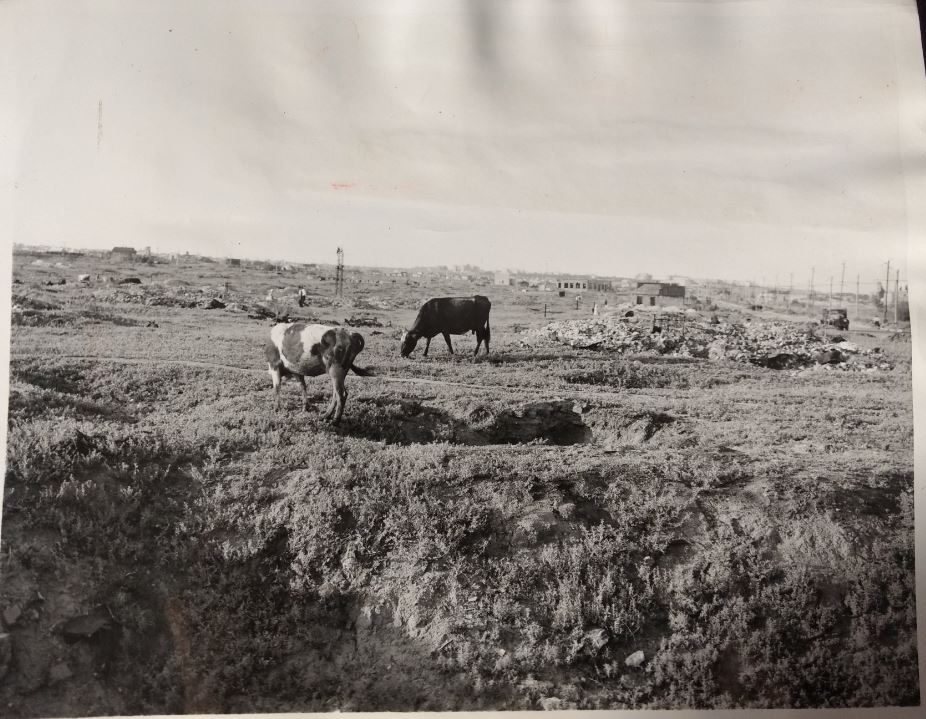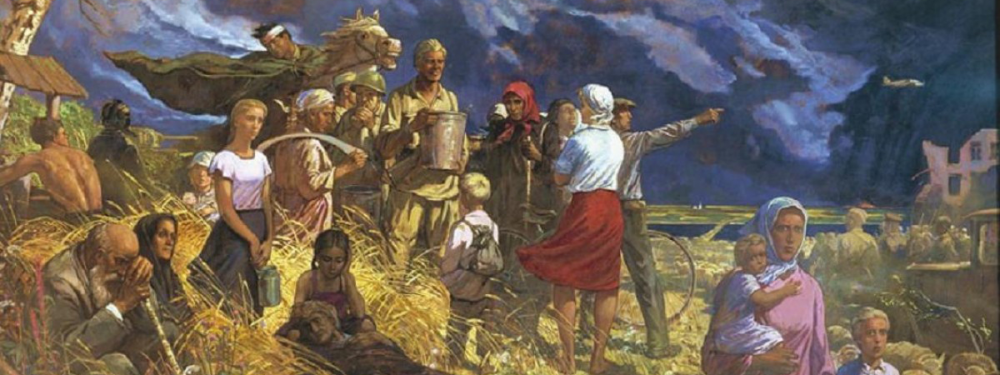I’ve purchased another of John Strohm’s photographs from his visit to the Soviet Union from his visit in 1946. This image shows cattle grazing in the ruins on the outskirts of Stalingrad. Without the caption to the image it would be impossible to tell this was Stalingrad. Cattle grazing on inappropriate plots of land, including mass graves and cemeteries, was a common post-war problem reguarly encountered in post-war archival reports.

This image captures something of the nature of the landscape of the warzone almost entirely laid waste by the experience of modern industrialized warfare. The shell-craters, and piles of rubble were redolent of many urban locations that after the war were closer to moonscapes than normal urban spaces.
Strohm’s visit to Stalingrad was one of a number taken by foreign visitors in the immediate aftermath. John Steinbeck and Robert Capa visited the city in 1947, also writing an account of the visit and taking a number of striking images. Indeed, Strohm’s account has often been overshadowed by the more literary and more visually polished A Russian Journal
This particular photograph was not published in the final version of his travelogue Just Tell the Truth, but Strohm did provide a fuller description of his encounter with this kind of ruined urban landscape:
A tour through the sepulchre-like ruins of Stalingrad – forty miles of shattered buildings, dugout homes, and rubble heaps – reveals both Russia’s strength and one of her weak points.
You see Stalingrad and you feel like taking your hat off, for here the battle tide was turned. You see ragged, barefoot people living in holes in the ground, trudging wearily to the battered factory once again turning out tractors instead of tanks. You see farmers cutting grain with sickles, stooping over to pick up unexploded shells, putting up hay with camels. They’re the people who saved Stalingrad, and perhaps the war, because they obeyed the simple order: “Die, but don’t give an inch!” Many died, but Stalingrad was saved.
Stalingrad should be a monument where the whole world pays homage to the little people who saved it. Yes, the people of Russia are her strength.
But in these very same ruins – and the ruins of countless other industrial centres – you see one of Russia’s weak points. They have a rebuilding program which makes out post-war problems seem like peanuts. I’m not a military strategist but I agree with a Russian friend who said to my confidentially:
“Any one who says the Soviet Union wants war is crazy – unless it is our leaders who are crazy, and that I do not believe. The people have been living on promises of better things in the sweet by and by ever since the Revolution. They accepted World War II as an excuse why they could not achieve a higher standard. Now they want to work for peacetime goals. Our government must consider the people – not war.”
One night I was walking down the street in Stalingrad. I passed the railroad station where a hundred people huddled on the ground. Some were sleeping, some talking in a low voice, other munched pieces of black bread, as they waited for the trains that never seemed to come.
In the daytime, I wondered where people lived in this devastation. At night, when I saw lights coming from the worst of these debris piles, I knew that somewhere in the wreckage they had cleared a room or a cellar to make a home.
I heard the sad music of a Russian accordion in the dark street ahead, and soon came to a crowd circled around couples who were dancing on the sidewalk. Girl danced with girl or biy, and boys even danced together.
“There’s no other place to go, nothing to do,” said the girl with whom I danced on the rough sidewalk. She and her sister live in a dugout and work in the Stalingrad tractor factory. But a dugout is no place for a nineteen-year-old girl on a warm night with a moon shining overhead. So she walks the streets with her friends of dances on the sidewalks.
She told me about the wonderful plans for rebuilding this city, how she gave a day of her time each week to help carry away the blasted bricks and other debris, as they go about the job of clearing the city three years after its liberation.
The next sat while watching a group of German prisoners at work on a road project in Stalingrad, I noticed a crippled Soviet soldier and his wife who had set down their heavy basket to rest. He handed his cane to his wife and started to roll a cigarette with a crumpled bit of newspaper.
Handing him an American cigarette, which he accepted with a flush of pleasure, I found out that he had just come from Tashkent, the capital of Uzbekistan. He was an Uzbek, his wife was a Russian. All of their possessions were in the baskets and boxes they were carrying. He had just arrived in Stalingrad.
He made a disdainful gesture towards the German prisoners who resembled a slow-motion version of a WPA crew at work. “Japanese prisoners in Tashkent are doing ten times as much work,” he remarked.
Later I visited the Stalingrad tractor factory, built with the help of American engineers in 1932. It switched from tank to tractor production at the end of 1942 and is now steadily getting back into introduction, with about two-thirds of the workers it had before the war. Still partially in ruins, this factory turned out 6,000 tractors in 1946.
Seventy thousand towns were completed razed – 30,000 industrial plants were either destroyed or stripped during the war.
Willard Thorp, Assistant Secretary of State, estimates that more than one-half of the total pre-war national wealth in western Russia was destroyed. And because of this giant rebuilding job, the total level of Russian wealth will be “only one-third that of the United States, even at the end of the present Five Year Plan.”
The millions of man hours put in on industrial reconstruction are man hours lost for such things as clothing and radios and furniture. Agricultural losses mean a continuation of a diet that leaves many Russians with a perpetually empty stomach.
Vodka toasts, like campaign oratory, usually go in one ear and out the other. But I’ll never forget one toast given by a government official. Among the things he said was:
“You have seen the destruction we have suffered. You have seen us working with cradles, with sickles and with flails. We want you to come again when we have put away these things. Some of you people say we want war. When you go back won’t you tell them – how can we possibly want war now when there is so much for us to do at home?”
Yes, problems of reconstruction are enormous, particularly in a nation which has so many problems of just plain construction roads which have never been built, factories which have never been put up, mines which have never been opened, forests which have never been entered.
The Soviet Union is an untapped giant of many facets.
John L. Strohm, Just Tell the Truth: The Uncensored Story of How the Common People Live Behind the Russian Iron Curtain (New York: Charles Scribner, 1947), 66-69.
I’ll be writing more about the urban reconstruction of Stalingrad over the course of this year, so it was good to find an image that I now have the rights to, which I can use in this research!
